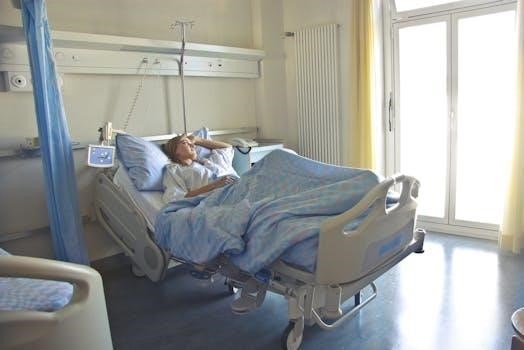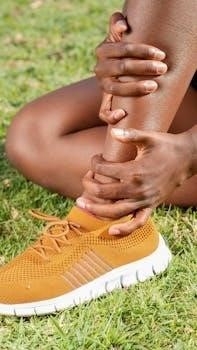
Hip fracture rehabilitation is crucial for restoring function after surgery, aiming to return patients to their pre-fracture mobility. It involves multidisciplinary care, beginning immediately after the operation, focusing on early mobilization and pain management.
Understanding Hip Fractures
Hip fractures are breaks in the upper femur, often resulting from falls or osteoporosis, particularly among the elderly. These fractures significantly impact mobility and independence, making rehabilitation essential. They are a leading cause of morbidity and disability, with numbers rising due to an aging population. Proper management, including timely surgery and comprehensive rehabilitation, is vital for improving outcomes and reducing the risk of complications, and mortality. Hip fractures are a major public health concern with considerable medical costs.

Immediate Post-Operative Care
Post-operative care starts immediately after surgery, focusing on pain management and early mobilization. It’s critical to initiate rehabilitation to prevent complications and improve patient recovery, with the goal of getting patients moving soon.
Mobilization on Day of or After Surgery
Early mobilization is a cornerstone of hip fracture rehabilitation, with most patients being encouraged to move on the day of, or the day after, their surgery. This immediate activity helps to reduce the risk of complications, like blood clots, and promotes a faster recovery. It also assists in regaining mobility and strength more quickly, which is vital for returning to pre-fracture function. This should be done with appropriate support from a physical therapist to ensure safety and effectiveness.
Pain Management and Early Rehabilitation
Effective pain management is essential for successful early rehabilitation after a hip fracture. Adequate pain relief allows patients to actively participate in therapy, facilitating movement and strengthening exercises. This approach includes both pharmacological and non-pharmacological interventions, tailored to individual needs. By addressing pain promptly, patients can achieve optimal outcomes from their early rehabilitation programs, which promotes improved functional recovery and shortens hospital stays. Effective pain management also encourages early mobilization and participation in physiotherapy.
Rehabilitation Standards and Guidelines
Established standards and guidelines, such as those from the CSP and AAOS, provide a framework for high-quality hip fracture rehabilitation. These guidelines ensure consistent, evidence-based care for all patients.
CSP Standards for Hip Fracture Physiotherapy
The Chartered Society of Physiotherapy (CSP) has established seven key standards for hip fracture physiotherapy. These standards mandate that all patients be mobilized on the day of, or the day after, their hip fracture surgery. Additionally, patients should receive at least two hours of rehabilitation per week post-surgery. These standards aim to deliver high-quality, evidence-based rehabilitation, reducing national variations in care and ensuring better patient outcomes following hip fracture.
AAOS Clinical Practice Guidelines
The American Academy of Orthopaedic Surgeons (AAOS) updated its Clinical Practice Guideline (CPG) for managing hip fractures in older adults in 2021. This update replaced the 2014 edition and includes over 80 evidence-based recommendations. The guidelines aim to provide a comprehensive approach to managing hip fractures, covering various aspects of care, including surgical techniques, rehabilitation protocols, and strategies for preventing future fractures. These guidelines are designed to enhance patient outcomes and improve care standards.

Multidisciplinary Approach to Rehabilitation
Effective hip fracture rehabilitation requires a team approach, including surgeons, physical therapists, and other healthcare professionals. This collaborative model ensures comprehensive care, addressing all patient needs for optimal recovery.
Importance of Multidisciplinary Teams
A multidisciplinary team approach is paramount in hip fracture rehabilitation, ensuring comprehensive care. This team typically includes surgeons, physical therapists, occupational therapists, nurses, and social workers. Their collaborative expertise addresses the diverse needs of patients, from surgical recovery to functional rehabilitation and psychosocial support. This integrated approach optimizes patient outcomes, reduces hospital stays, and facilitates a smoother transition back to independent living, enhancing overall quality of life after a hip fracture.
Role of Physical Therapists in Rehabilitation
Physical therapists play a central role in hip fracture rehabilitation, guiding patients through structured exercise programs. They focus on improving strength, mobility, balance, and gait. Therapists also educate patients on proper techniques to prevent falls and future injuries. Their expertise ensures that rehabilitation aligns with evidence-based practices, maximizing functional recovery and independence. They tailor interventions to individual needs, continuously assessing progress and adjusting treatment plans as necessary for optimal outcomes.

Key Elements of Rehabilitation Programs
Rehabilitation programs emphasize exercises to improve strength and movement. These programs also focus on upright posture and balance training, crucial for regaining mobility and preventing future falls.
Exercises to Improve Strength and Movement
Exercises are vital for regaining strength and movement after a hip fracture. These often include gentle range-of-motion exercises, progressing to strengthening exercises targeting the hip, leg, and core muscles. Early mobilization, such as walking with assistive devices, is introduced to enhance mobility. The exercises are carefully chosen and adapted based on individual needs, considering the patient’s pre-fracture condition and surgical procedure, to ensure safe and effective recovery. Proper technique and gradual progression are key aspects of this component.
Focus on Upright Posture and Balance
Rehabilitation after a hip fracture places significant emphasis on regaining upright posture and balance. This involves specific exercises and activities designed to improve core stability and proprioception. Maintaining an upright posture is vital for functional movement and preventing falls. Balance training is crucial to reduce the risk of future falls, which is a key concern for elderly individuals recovering from hip fractures. The interventions are tailored to each patient’s abilities, incorporating gradual progression to improve stability and confidence.
Long-Term Rehabilitation and Goals
Long-term rehabilitation focuses on returning patients to their pre-fracture functional level and maximizing independence. The goal is to enhance quality of life and ensure long-term mobility and stability.
Returning to Pre-Fracture Function
A primary goal of hip fracture rehabilitation is to facilitate the patient’s return to their pre-injury functional status. This involves a comprehensive approach that addresses strength, mobility, and balance. For many seniors who were ambulatory prior to the fracture, the aim is to regain their ability to perform daily activities independently. The rehabilitation plan is tailored to each individual, considering their unique needs and pre-existing level of activity. Multidisciplinary teams work together to ensure the best possible outcomes, focusing on restoring mobility and independence.
Maximizing Independence and Quality of Life
Rehabilitation programs after hip fracture surgery are designed to maximize independence and enhance the patient’s overall quality of life. The focus is not only on physical recovery but also on empowering individuals to manage daily activities with confidence. By addressing both physical and psychosocial aspects of recovery, rehabilitation aims to improve mobility, reduce pain, and promote self-reliance. This comprehensive approach supports long-term well-being and allows patients to engage in meaningful activities and maintain their social connections, contributing to a higher quality of life post-fracture.
Community-Based Rehabilitation
Community-based rehabilitation extends care beyond hospital settings, offering continued support for hip fracture patients. These programs aim to integrate patients back into their daily routines and environments.
Interventions for Older Adults with Cognitive Impairment
Rehabilitation for older adults with cognitive impairment after a hip fracture requires tailored approaches; These interventions should focus on simplified instructions and consistent routines to maximize engagement. Caregivers and family involvement are essential to reinforce rehabilitation strategies. Modifications to the environment may also be necessary to ensure safety and promote independence. It is vital to monitor for progress and adapt therapy accordingly, considering the individual’s cognitive and physical limitations. The goal is to improve function and quality of life despite cognitive challenges.
Addressing Complications and Co-morbidities
Managing post-operative complications, such as infections, and addressing pre-existing conditions is crucial in hip fracture rehabilitation. This holistic approach ensures better outcomes, minimizing risks and enhancing recovery.
Managing Post-Operative Complications
Post-operative care for hip fractures involves monitoring for complications like infections, deep vein thrombosis, and pneumonia. Early detection and management are vital to prevent prolonged hospital stays and ensure optimal rehabilitation outcomes. Pain management is also critical, allowing patients to participate effectively in physical therapy. Addressing these issues promptly can significantly improve recovery and reduce the risk of readmission, contributing to better overall health and function following hip fracture surgery.

Prevention of Future Fractures
Preventing future fractures requires lifestyle adjustments, including dietary changes for bone health and regular exercise. Bone density screenings and medications may also be necessary to reduce risks of further fractures.
Lifestyle Changes and Bone Health
Adopting healthy lifestyle choices is crucial in preventing future hip fractures. This includes maintaining a balanced diet rich in calcium and vitamin D, vital for bone strength. Regular weight-bearing exercise, such as walking, helps improve bone density. Avoiding smoking and limiting alcohol consumption are also important. Additionally, fall prevention strategies, like home modifications and balance training, are key in reducing the risk of future incidents. These measures are essential to maintaining long-term bone health.